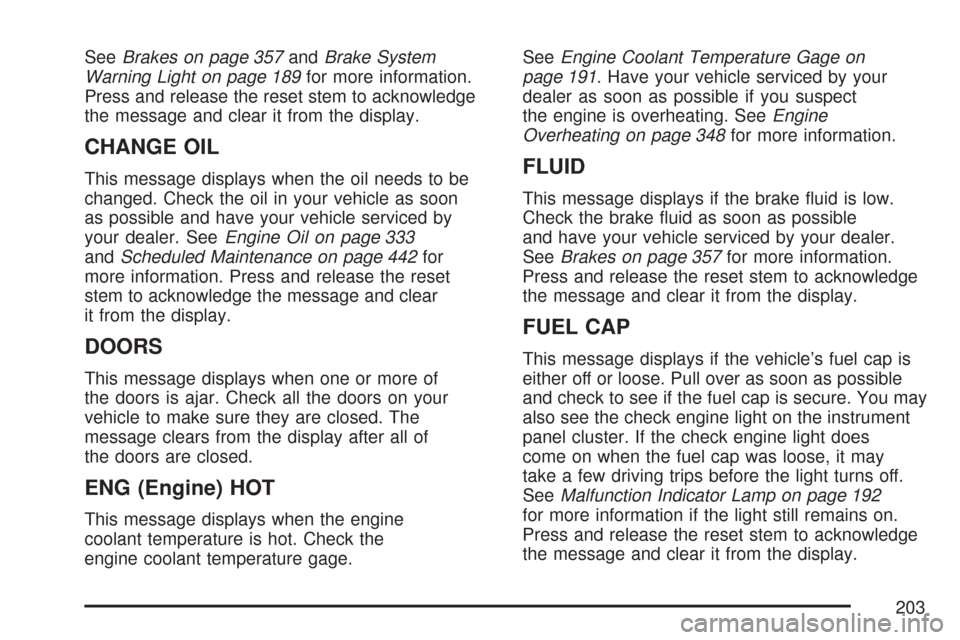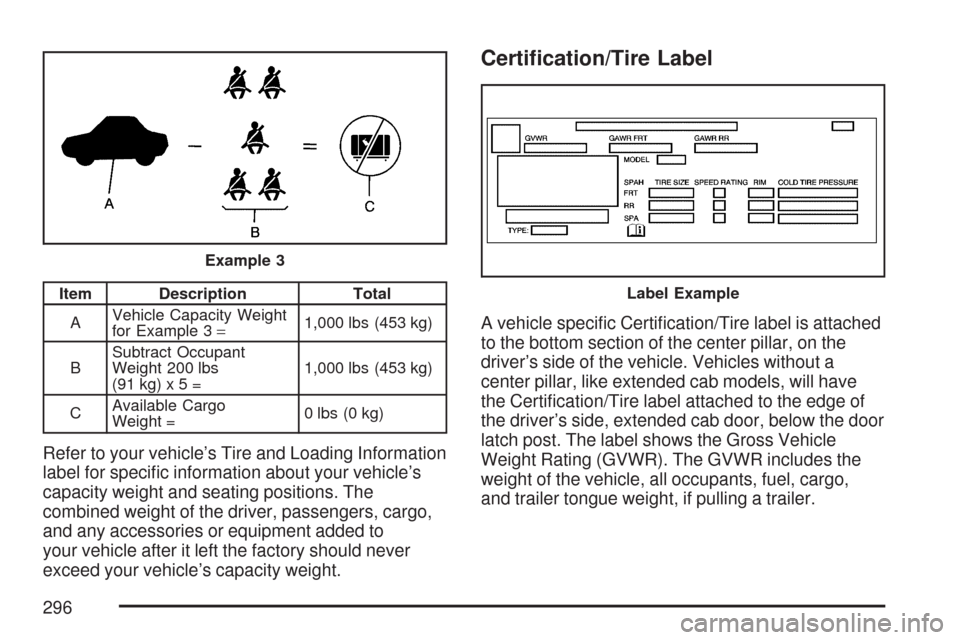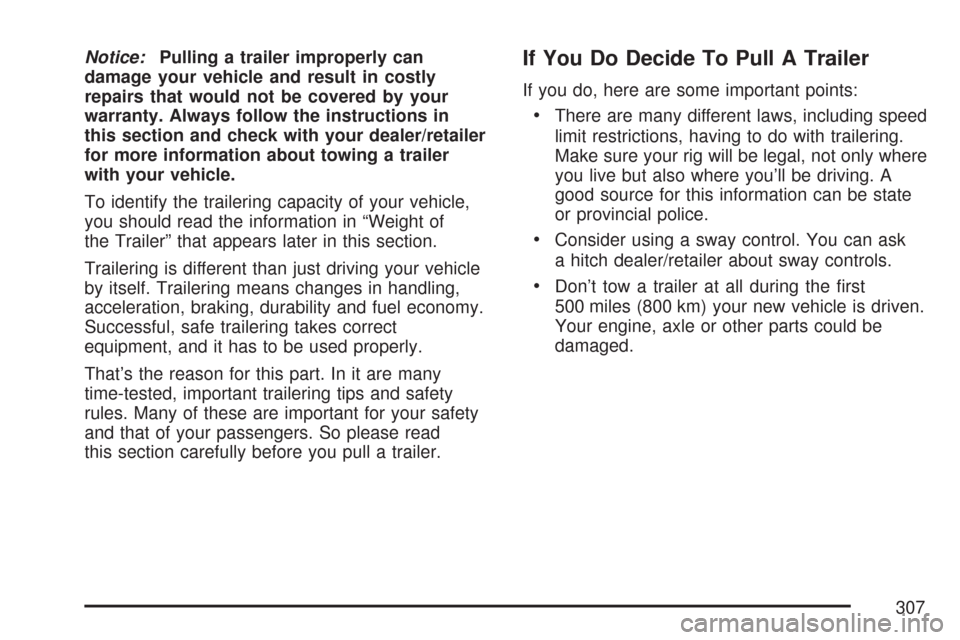2007 CHEVROLET COLORADO fuel cap
[x] Cancel search: fuel capPage 2 of 496

Service and Appearance Care
.................. 321
Service
................................................. 324
Fuel
...................................................... 326
Checking Things Under the Hood
......... 331
Rear Axle
............................................. 368
Four-Wheel Drive
.................................. 368
Front Axle
............................................ 369
Bulb Replacement
................................ 370
Windshield Wiper Blade
Replacement
..................................... 375
Tires
..................................................... 377
Appearance Care
.................................. 422Vehicle Identi�cation
............................. 432
Electrical System
.................................. 432
Capacities and Speci�cations
................ 437
Maintenance Schedule
.............................. 439
Maintenance Schedule
.......................... 440
Customer Assistance Information
............. 459
Customer Assistance and Information
..... 460
Reporting Safety Defects
...................... 475
Vehicle Data Recording and Privacy
..... 478
Index
.......................................................... 481
2
Page 193 of 496

This light should come on, as a check to show you
it is working, when the ignition is on and the engine
is not running. If the light does not come on, have
it repaired. This light will also come on during a
malfunction in one of two ways:
Light Flashing— A mis�re condition has been
detected. A mis�re increases vehicle emissions
and may damage the emission control system
on your vehicle. Diagnosis and service may
be required.
Light On Steady— An emission control
system malfunction has been detected on
your vehicle. Diagnosis and service may
be required.
If the Light is Flashing
The following may prevent more serious damage
to your vehicle:
Reducing vehicle speed
Avoiding hard accelerations
Avoiding steep uphill grades
If you are towing a trailer, reduce the
amount of cargo being hauled as soon
as it is possibleIf the light stops �ashing and remains on steady,
see “If the Light Is On Steady” following.
If the light continues to �ash, when it is safe to
do so, stop the vehicle. Find a safe place to park
your vehicle. Turn the key off, wait at least
10 seconds and restart the engine. If the light
remains on steady, see “If the Light Is On Steady”
following. If the light is still �ashing, follow the
previous steps, and see your dealer for service
as soon as possible.
If the Light Is On Steady
You may be able to correct the emission system
malfunction by considering the following:
Did you recently put fuel into your vehicle?
If so, reinstall the fuel cap, making sure to fully
install the cap. SeeFilling the Tank on page 328.
The diagnostic system can determine if the
fuel cap has been left off or improperly installed.
A loose or missing fuel cap will allow fuel to
evaporate into the atmosphere. A few driving
trips with the cap properly installed should turn
the light off.
193
Page 197 of 496

Daytime Running Lamps (DRL)
Indicator Light
This light turns
on whenever the
Daytime Running
Lamps are on.
SeeDaytime Running Lamps (DRL) on page 171
for more information.
Fuel Gage
When the ignition
is on, the fuel gage
tells you about
how much fuel you
have remaining in
the fuel tank.Here are four things that some owners ask
about. None of these indicate a problem with
your fuel gage:
At the gas station, the gas pump shuts off
before the gage reads full.
It takes a little more or less fuel to �ll up than
the gage indicated. For example, the gage
may have indicated the tank was half full,
but it actually took a little more or less than
half the tank’s capacity to �ll the tank.
The gage moves a little when you turn a
corner or speed up.
The gage does not go back to empty when
you turn off the ignition.
When the fuel in the fuel tank is low, you will see
a LOW FUEL message on the Driver Information
Center (DIC) display. SeeDIC Warnings and
Messages on page 202for more information.
197
Page 203 of 496

SeeBrakes on page 357andBrake System
Warning Light on page 189for more information.
Press and release the reset stem to acknowledge
the message and clear it from the display.
CHANGE OIL
This message displays when the oil needs to be
changed. Check the oil in your vehicle as soon
as possible and have your vehicle serviced by
your dealer. SeeEngine Oil on page 333
andScheduled Maintenance on page 442for
more information. Press and release the reset
stem to acknowledge the message and clear
it from the display.
DOORS
This message displays when one or more of
the doors is ajar. Check all the doors on your
vehicle to make sure they are closed. The
message clears from the display after all of
the doors are closed.
ENG (Engine) HOT
This message displays when the engine
coolant temperature is hot. Check the
engine coolant temperature gage.SeeEngine Coolant Temperature Gage on
page 191. Have your vehicle serviced by your
dealer as soon as possible if you suspect
the engine is overheating. SeeEngine
Overheating on page 348for more information.
FLUID
This message displays if the brake �uid is low.
Check the brake �uid as soon as possible
and have your vehicle serviced by your dealer.
SeeBrakes on page 357for more information.
Press and release the reset stem to acknowledge
the message and clear it from the display.
FUEL CAP
This message displays if the vehicle’s fuel cap is
either off or loose. Pull over as soon as possible
and check to see if the fuel cap is secure. You may
also see the check engine light on the instrument
panel cluster. If the check engine light does
come on when the fuel cap was loose, it may
take a few driving trips before the light turns off.
SeeMalfunction Indicator Lamp on page 192
for more information if the light still remains on.
Press and release the reset stem to acknowledge
the message and clear it from the display.
203
Page 296 of 496

Item Description Total
AVehicle Capacity Weight
for Example 3=1,000 lbs (453 kg)
BSubtract Occupant
Weight 200 lbs
(91 kg) x 5 =1,000 lbs (453 kg)
CAvailable Cargo
Weight =0 lbs (0 kg)
Refer to your vehicle’s Tire and Loading Information
label for speci�c information about your vehicle’s
capacity weight and seating positions. The
combined weight of the driver, passengers, cargo,
and any accessories or equipment added to
your vehicle after it left the factory should never
exceed your vehicle’s capacity weight.
Certi�cation/Tire Label
A vehicle speci�c Certi�cation/Tire label is attached
to the bottom section of the center pillar, on the
driver’s side of the vehicle. Vehicles without a
center pillar, like extended cab models, will have
the Certi�cation/Tire label attached to the edge of
the driver’s side, extended cab door, below the door
latch post. The label shows the Gross Vehicle
Weight Rating (GVWR). The GVWR includes the
weight of the vehicle, all occupants, fuel, cargo,
and trailer tongue weight, if pulling a trailer.
Example 3
Label Example
296
Page 307 of 496

Notice:Pulling a trailer improperly can
damage your vehicle and result in costly
repairs that would not be covered by your
warranty. Always follow the instructions in
this section and check with your dealer/retailer
for more information about towing a trailer
with your vehicle.
To identify the trailering capacity of your vehicle,
you should read the information in “Weight of
the Trailer” that appears later in this section.
Trailering is different than just driving your vehicle
by itself. Trailering means changes in handling,
acceleration, braking, durability and fuel economy.
Successful, safe trailering takes correct
equipment, and it has to be used properly.
That’s the reason for this part. In it are many
time-tested, important trailering tips and safety
rules. Many of these are important for your safety
and that of your passengers. So please read
this section carefully before you pull a trailer.If You Do Decide To Pull A Trailer
If you do, here are some important points:
There are many different laws, including speed
limit restrictions, having to do with trailering.
Make sure your rig will be legal, not only where
you live but also where you’ll be driving. A
good source for this information can be state
or provincial police.
Consider using a sway control. You can ask
a hitch dealer/retailer about sway controls.
Don’t tow a trailer at all during the �rst
500 miles (800 km) your new vehicle is driven.
Your engine, axle or other parts could be
damaged.
307
Page 321 of 496

Service........................................................ 324
Accessories and Modi�cations................... 324
California Proposition 65 Warning.............. 324
Doing Your Own Service Work.................. 325
Adding Equipment to the
Outside of Your Vehicle......................... 325
Fuel............................................................. 326
Gasoline Octane........................................ 326
Gasoline Speci�cations.............................. 326
California Fuel........................................... 326
Additives................................................... 326
Fuels in Foreign Countries........................ 327
Filling the Tank......................................... 328
Filling a Portable Fuel Container............... 330
Checking Things Under the Hood.............. 331
Hood Release........................................... 331
Engine Compartment Overview.................. 332
Engine Oil................................................. 333
Engine Oil Life System.............................. 336Engine Air Cleaner/Filter............................ 338
Automatic Transmission Fluid.................... 339
Manual Transmission Fluid........................ 342
Hydraulic Clutch........................................ 344
Engine Coolant.......................................... 345
Radiator Pressure Cap.............................. 348
Engine Overheating................................... 348
Cooling System......................................... 350
Engine Fan Noise..................................... 355
Power Steering Fluid................................. 355
Windshield Washer Fluid........................... 356
Brakes...................................................... 357
Battery...................................................... 361
Jump Starting............................................ 362
Rear Axle.................................................... 368
Four-Wheel Drive........................................ 368
Front Axle................................................... 369
Section 5 Service and Appearance Care
321
Page 328 of 496

Filling the Tank
{CAUTION:
Fuel vapor burns violently and a fuel �re
can cause bad injuries. To help avoid
injuries to you and others, read and follow
all the instructions on the pump island.
Turn off your engine when you are
refueling. Do not smoke if you are near
fuel or refueling your vehicle. Do not use
cellular phones. Keep sparks, �ames,
and smoking materials away from fuel.
Do not leave the fuel pump unattended
when refueling your vehicle. This is
against the law in some places. Do not
re-enter the vehicle while pumping fuel.
Keep children away from the fuel pump;
never let children pump fuel.The tethered fuel cap is located behind a hinged
fuel door on the driver’s side of the vehicle.
To remove the fuel cap, turn it slowly
counterclockwise.
While refueling, hang the tethered fuel cap from
the hook on the fuel door.
328